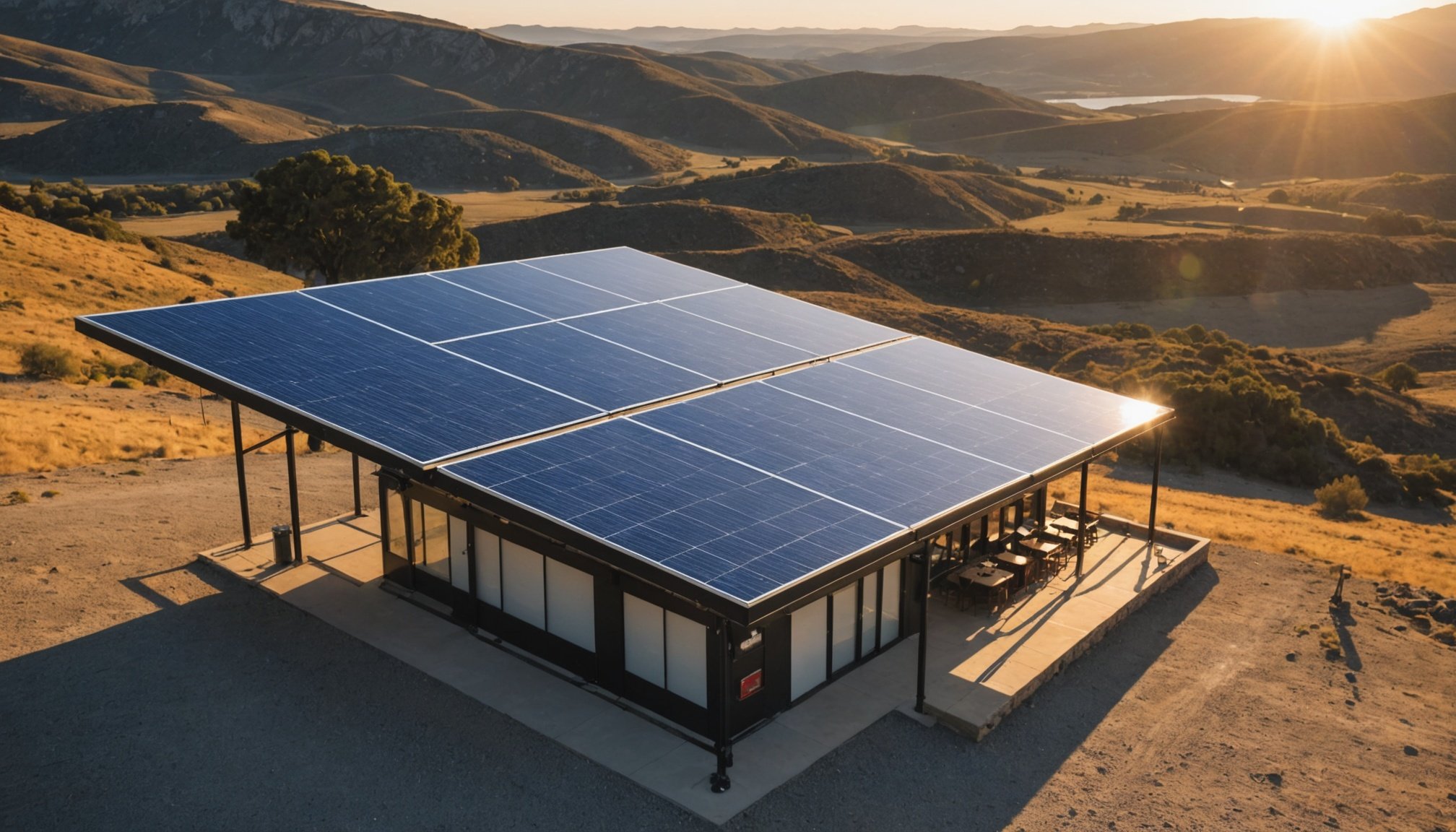Remote dining establishments face unique challenges, particularly in accessing reliable energy sources. Harnessing solar energy offers a promising solution, providing sustainability and potential cost savings. However, this approach comes with its own set of obstacles, such as initial investment and space limitations. Understanding both the advantages and challenges of solar power is essential for these businesses aiming for a brighter, greener future. Join us as we explore the intricate balance of solar energy’s benefits and the hurdles that remote dining establishments must overcome to thrive.
Understanding Solar Energy for Remote Dining Establishments
Exploring the potential of renewable energy solutions for isolated locations.
Have you seen this : Essential Guidelines for Safely Preparing and Serving Raw Shellfish in Seafood Restaurants
Definition and Principles of Solar Energy
Solar energy is the power harnessed from the sun's rays. It is a renewable energy source, meaning it can be replenished naturally. The sun's energy is captured using photovoltaic cells, which convert sunlight into electricity. This process is vital for remote restaurants that are often located far from traditional power grids.
Importance of Solar Energy for Remote Locations
For dining establishments in remote areas, solar energy offers a reliable and sustainable power solution. These locations often face challenges in accessing conventional energy sources. By using solar power, they can reduce dependency on fossil fuels and lower operational costs. This makes solar energy not only an environmentally friendly choice but also an economically viable one.
In the same genre : Key Ingredients for Launching a Thriving Pop-Up Restaurant Experience
Overview of Solar Energy Systems for Dining Establishments
Several solar energy systems can be implemented in remote dining settings:
- Photovoltaic Panels: Convert sunlight into electricity.
- Solar Water Heaters: Use solar power to heat water.
- Battery Storage Systems: Store excess energy for use during non-sunny hours.
These systems ensure that remote restaurants have a continuous supply of energy, enhancing their operational efficiency and sustainability. By investing in solar energy, dining establishments can enjoy the benefits of a clean and renewable power source.
Advantages of Solar Energy for Remote Dining Establishments
Exploring the benefits and practicality of solar solutions.
Reduction in Energy Costs
Implementing solar energy systems in remote dining establishments leads to substantial cost savings. Once the initial investment is made, the energy costs significantly decrease over time. Traditional power sources can be expensive and unpredictable, especially in isolated areas. By harnessing the sun's power, restaurants can stabilize their budgets with predictable and lower energy costs.
Positive Environmental Impact
Solar energy contributes to a positive environmental impact by reducing the carbon footprint of dining establishments. Unlike fossil fuels, solar power generates clean electricity, which helps combat climate change. This environmentally friendly approach not only benefits the planet but also enhances the restaurant's reputation among eco-conscious consumers.
Enhanced Energy Independence
Remote establishments gain energy independence with solar energy systems, reducing reliance on external power sources. This independence ensures a reliable energy supply, even in remote locations. Solar energy systems, such as photovoltaic panels and battery storage, empower restaurants to operate efficiently without disruptions.
- Key Benefits:
- Lower long-term energy costs
- Reduced carbon footprint
- Increased energy independence
Investing in solar energy is a strategic move for remote dining establishments, offering both economic and environmental advantages.
Challenges of Implementing Solar Energy
Exploring obstacles faced by remote dining establishments.
High Upfront Installation Costs
Implementing solar energy systems can be daunting due to the high upfront installation costs. These expenses often deter small remote dining establishments from transitioning to renewable energy. However, various financing options are available, such as government incentives and loans, which can alleviate the initial financial burden.
Technical Challenges in Remote Areas
Remote locations present unique technical challenges for installing solar energy systems. The installation process can be complicated by difficult terrain and limited access to skilled labor. These factors can increase both the time and cost of setting up a solar energy system. Overcoming these challenges requires careful planning and potentially hiring specialized installation teams.
Ongoing Maintenance Requirements
Once installed, solar energy systems require regular maintenance to ensure optimal performance. This involves cleaning photovoltaic panels and checking battery storage for efficiency. Potential issues, such as weather damage or equipment wear, necessitate periodic inspections. This ongoing maintenance can be challenging in remote areas, where access to repair services might be limited.
- Key Challenges:
- High upfront installation costs
- Technical challenges in remote areas
- Ongoing maintenance requirements
Understanding these challenges helps dining establishments make informed decisions about adopting solar energy, ensuring they are prepared for both the benefits and potential hurdles.
Financial Incentives and Support for Solar Energy Adoption
Exploring financial opportunities for embracing solar solutions.
Government Grants and Subsidies
For remote dining establishments, financial incentives can significantly reduce the cost of adopting solar energy. Various government grants and subsidies are available to support businesses transitioning to renewable energy. These programs aim to alleviate the high upfront costs of solar installations, making it more feasible for small establishments to invest in sustainable solutions. By taking advantage of these financial incentives, restaurants can make a cost-effective shift to solar power.
Tax Credits for Solar Solutions
Businesses can benefit from tax credits when they adopt solar energy systems. These credits reduce the overall tax liability, providing a financial boost to establishments investing in renewable energy. The federal investment tax credit (ITC) is one such example, offering a percentage deduction of the installation costs. Utilizing these tax credits not only supports financial savings but also encourages more businesses to consider solar energy.
Financial Case Studies
Several dining establishments have successfully leveraged financial incentives to achieve a positive return on investment (ROI) with solar energy. For example, a remote café utilized government grants and tax credits to cover 30% of their installation costs, resulting in significant energy savings over five years. These case studies highlight the practical benefits and encourage other establishments to explore similar opportunities.
Energy Storage Solutions for Remote Dining Establishments
Exploring reliable power options beyond solar energy.
Importance of Energy Storage
For remote dining establishments, energy storage is crucial in ensuring a consistent power supply. While solar panels capture energy during the day, battery systems store excess energy for use during non-sunny hours. This off-grid solution provides stability and reliability, reducing dependence on external power sources. In the absence of a continuous energy supply, restaurants risk operational disruptions, which can affect customer satisfaction and revenue.
Types of Battery Systems
Several types of battery systems are suitable for remote restaurants. Lithium-ion batteries are popular due to their high energy density and long lifespan. Lead-acid batteries, though less efficient, offer a cost-effective option for smaller establishments. Flow batteries provide scalability and are ideal for larger operations with significant energy needs. Each system has its merits, and the choice depends on the restaurant's specific requirements and budget.
Case Studies
Successful energy storage implementations showcase the benefits of these systems. A coastal restaurant in Maine adopted lithium-ion batteries, achieving energy independence and reducing costs by 40%. Another establishment in the Rockies opted for flow batteries, ensuring uninterrupted service during peak tourist seasons. These examples highlight how strategic investment in energy storage can transform operations for remote dining establishments.
- Key Battery Systems:
- Lithium-ion
- Lead-acid
- Flow batteries
Case Studies of Successful Solar Energy Implementation
Exploring practical examples of solar energy in remote dining establishments.
Successful Examples
Many remote restaurants have embraced solar energy with remarkable success. One example is a mountain lodge in Colorado that implemented a comprehensive solar system. This establishment reduced its energy costs by 50% within the first year, demonstrating the financial viability of solar solutions. Another case involves a beachfront café in California, which installed photovoltaic panels and battery storage systems. This setup not only ensured a continuous power supply but also enhanced its reputation among eco-conscious travelers.
Lessons Learned
These case studies offer valuable insights into the effective use of solar energy. Key lessons include the importance of selecting the right solar technology and the need for regular maintenance to ensure system efficiency. Additionally, leveraging financial incentives can significantly offset initial investment costs.
Best Practices for Implementation
- Conduct a thorough site assessment to determine the most suitable solar energy system.
- Engage with experienced installers to navigate technical challenges.
- Utilize available government grants and tax credits to reduce financial barriers.
- Implement a robust maintenance plan to maximize system longevity.
These best practices guide remote dining establishments in successfully adopting solar energy, ensuring both operational efficiency and sustainability.
Expert Opinions on Solar Energy for Remote Dining
Exploring insights from industry leaders and experts.
Interviews with Experts
Solar energy experts and restaurant owners provide valuable insights into the adoption of solar solutions in remote dining. Dr. Lisa Chang, a renewable energy consultant, emphasizes the cost-effectiveness and sustainability of solar systems. She states, "The initial investment may be high, but the long-term savings are substantial." Restaurant owner Mark Diaz shares, "Our solar installation has not only reduced our expenses but also attracted eco-conscious customers."
Analysis of Expert Predictions
Industry predictions suggest that solar energy will become increasingly integral to the restaurant sector. Experts forecast a significant rise in solar installations as technology advances and costs decrease. A recent report highlights that by 2030, solar energy could power up to 40% of remote dining establishments, driven by technological improvements and financial incentives.
Perspectives on the Future
The future of solar energy in remote dining looks promising. Experts believe that innovations in solar technology and energy storage will further enhance efficiency and reliability. As environmental awareness grows, restaurants adopting solar solutions will likely gain a competitive edge.
- Key Takeaways:
- Cost-effectiveness of solar systems
- Growing customer attraction to sustainable practices
- Technological advancements boosting solar adoption
Solutions to Overcome Barriers to Solar Energy Adoption
Exploring innovative strategies for successful implementation.
Innovative Technologies
Adopting solar solutions in remote dining establishments can be challenging, but innovative technologies are simplifying the process. Smart inverters and microgrid systems enhance the efficiency of solar installations, making them more accessible. These technologies reduce the complexity of setup and maintenance, thus overcoming barriers to solar energy adoption.
Community-Based Approaches
Community-based approaches foster collaboration among remote restaurants to share resources and expertise. By forming solar cooperatives, establishments can pool funds to invest in shared solar infrastructure. This strategy not only reduces costs but also accelerates the implementation of solar solutions.
Maximizing Solar Energy Benefits
To maximize the benefits of solar energy, restaurants should implement strategic measures. Conducting regular energy audits helps identify areas for improvement and optimize solar system performance. Additionally, investing in energy-efficient appliances complements solar installations, further reducing energy consumption.
- Key Strategies:
- Utilize smart inverters for efficient energy conversion
- Form solar cooperatives for shared resources
- Conduct energy audits to enhance system performance
By adopting these strategies, remote dining establishments can effectively overcome barriers to solar energy adoption, ensuring sustainable and efficient operations.
The Future of Solar Energy in Remote Dining Establishments
Emerging trends and innovations shaping the landscape.
Emerging Trends in Solar Technology
The future of solar energy in remote dining is promising, with emerging trends revolutionizing the industry. Innovations such as bifacial solar panels and solar tracking systems enhance efficiency by capturing more sunlight. These advancements are crucial for remote locations where maximizing energy yield is essential. The potential integration of artificial intelligence into solar systems further optimizes performance, allowing establishments to predict and manage energy usage effectively.
Predictions for Growth in Remote Areas
Industry experts predict a significant increase in solar energy adoption in remote areas. As technology becomes more affordable and efficient, more dining establishments are expected to transition to solar solutions. A report forecasts that by 2030, solar energy could power a substantial portion of remote restaurants, driven by decreasing costs and rising environmental awareness.
Integration with Other Renewable Sources
The potential for integration with other renewable energy sources presents exciting opportunities. Combining solar energy with wind or hydropower can create hybrid systems, providing a more reliable energy supply. This synergy not only enhances sustainability but also ensures a continuous power flow, crucial for maintaining uninterrupted restaurant operations.
- Key Innovations:
- Bifacial solar panels
- Solar tracking systems
- AI integration for energy management
These developments underscore the transformative potential of solar energy in remote dining, paving the way for a sustainable future.











